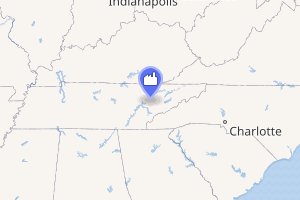Bull Run Fossil Plant
Bull Run Fossil Plant, commonly known as Bull Run Steam Plant, is a 889 megawatt (MW), coal-fired electric generating station owned and operated by the Tennessee Valley Authority (TVA). The plant is the only coal fired power plant ever constructed by TVA with one unit, and is expected to close in 2023.
| Bull Run Fossil Plant | |
|---|---|
Bull Run Fossil Plant from north viewing area | |

| |
| Country | United |
| Location | Claxton, Anderson County, Tennessee, directly across the Clinch River (Melton Hill Lake) from Oak Ridge |
| Coordinates | 36°01′16″N 84°09′22″W |
| Status | Operational |
| Commission date | 1967 |
| Decommission date | December 2023 (planned) |
| Owner(s) | Tennessee Valley Authority (TVA) |
| Operator(s) | |
| Thermal power station | |
| Primary fuel | Coal |
| Turbine technology | ABB-CE coal-fired supercritical boiler |
| Power generation | |
| Units operational | 1, General Electric cross compound turbine |
| Nameplate capacity | 889 MW |
| External links | |
| Commons | Related media on Commons |
Location
Bull Run Plant is located on 750 acres (300 ha), in the Claxton community of Anderson County, Tennessee, on the north bank of Bull Run Creek, directly across the Clinch River (Melton Hill Lake) from Oak Ridge, Tennessee.
History
Construction began on April 2, 1962 and was completed on June 12, 1967, when the plant began commercial operation.[1]
In August 2018, TVA began studying whether to retire Bull Run.[2] On February 14, 2019, the TVA board of directors voted 5-2 to close Bull Run by December 2023, as well as the remaining coal unit at Paradise in Kentucky by December 2020. High operational costs and low capacity were its factors in their decision.[3]
Units and operating parameters
The plant is the only single-generator coal-fired plant in the TVA system. The plant's winter net generating capacity is about 889 MWe.[4][5] The plant consumes 7,300 short tons (6,600 t) of coal per day,[1] and requires 3,200 short tons (2,900 t) of cooling water per hour. Its supercritical boiler operates at a pressure of 3,650 psi (248 atm) and temperature of 1,000 °F (540 °C). When the generator first went into operation, it was the largest in the world measured in terms of the volume of steam produced.
Environmental impact
In 2006, the plant ranked the 70th among the large coal-fired plants in the United States on the list of worst SO2 polluters, having emitted 11.92 lb (5.41 kg) of sulfur dioxide per MWh of energy produced (27,987 tons of SO2 in 2006 altogether).[6][7]
Since then, a wet limestone scrubber has been installed, which reduced sulfur dioxide emissions by about 95%. In 2015, the plant released 2,510,476 tons of CO
2.[8]
See also
References
| Wikimedia Commons has media related to Bull Run Fossil Plant. |
- "Bull Run fossil plant". Tennessee Valley Authority. Archived from the original on August 15, 2007.
- Flessner, Dave (August 27, 2018). "Trouble in Paradise: TVA studies whether to close more coal plants". Chattanooga Times Free Press. Chattanooga, Tennessee. Retrieved February 14, 2019.
- Gardner, Timothy (February 14, 2019). "U.S. utility TVA votes to close two coal power plants, in blow to Trump". Reuters. Retrieved February 14, 2019.
- "Existing Electric Generating Units in the United States, 2006" (Excel). Energy Information Administration, U.S. Department of Energy. 2006. Retrieved July 14, 2008.
- TVA's website lists the winter generating capacity as 870 MW Archived August 15, 2007, at the Wayback Machine
- "Dirty Kilowatts 2007 Report Database". Environmental Integrity Project. Archived from the original on December 4, 2008. Retrieved May 1, 2008.
- "Technology Transfer Network: State Emission Index". U.S. Environmental Protection Agency. Retrieved May 2008. Check date values in:
|accessdate=(help) - "TVA - Bull Run Fossil Plant Emissions". January 25, 2017. Archived from the original on January 25, 2017. Retrieved March 19, 2017.